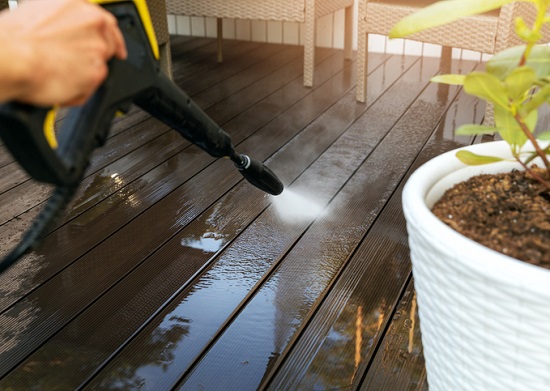Composite Decking Aftercare
Reading time: 5 minutes
While composite decking is hard-wearing, it will still require maintenance and care as time goes by. Read on for the answers to commonly asked questions about care of composite decking.
Does composite decking get mould?
Mould can grow on almost any surface exposed to the elements, and composite decking is no different. Decaying leaves or insects and dirt or debris will all cause mould to thrive, especially in damp air and mild temperatures.
Of course, you can’t control weather conditions, but there are ways of having more control over mould. Keeping your decking boards clean will help greatly. Simply sweeping will help, as this prevents fallen leaves and dirt from taking hold in between the cracks of the boards. As this kind of debris breaks down, mould, moss and algae can form.
Regular sweeping is good practice in the short term, however occasional deep cleans are essential when taking care of composite decking. Thoroughly cleaning your decking quarterly is preferable for keeping it looking its best, but even twice a year is worthwhile and would make a great difference to long-term preservation.
As previously mentioned, the damp air and heat that is typical of a British summer provides the perfect conditions for mould to grow in, so a deep clean before summer is a good idea. Cleaning again once the summer is over removes traces of mould that managed to develop over the season, meaning spring and autumn are the best times in the gardening calendar for thorough deck cleaning.
How to clean composite decking
While it might not be a quick job to clean decking, it’s worth being thorough. Follow these steps to give your composite decking a good cleaning to help keep it looking better for longer.
- Remove all furniture, plants and any other obstacles
- Loosen any dirt
- Wash it all away
- Clearing snow and ice
How do you protect composite decking from scratches?
In the same way it’s not possible to keep your decking completely free of dirt and mould, your decking is also likely to pick up marks and scratches over the course of its life. It’s there to be walked on, have garden furniture placed on it and is generally quite hardwearing for these reasons. However, it’s reasonable to want to retain the ‘just new’ look for as long as possible.
Adding rubber or plastic pads to your furniture, especially for metal tables and chairs, will help to reduce composite decking scratches. For plant pots and other decorative items, rubber mats are an effective way of protecting composite decking.
Does composite decking warp, and what can be done about it?
Besides surface issues, there are circumstances where decking can slightly distort. Because of the way composite decking is made, using mostly synthetic and repurposed materials, it’s not prone to warping in the way solid wood decking is. However, it’s possible for composite decking to sag.
If you’ve noticed this, it might be more to do with the decking’s installation, and usually means that joists haven’t been correctly installed with the right spacing. If sagging does start to occur, it might mean some maintenance is required under the decking. Check with the manufacturer before starting any costly work.
Taking care of your decking need not be an ongoing chore, but a case of cleaning every few months and watching for dirt and damage. We can help you look after your decking with garden and landscaping accessories, available to order now.
Disclaimer: The information contained on this page is intended as an overall introduction and is not intended as specific advice from a qualified professional. Travis Perkins aims to avoid, but accepts no liability, in the case that any information stated is out of date.











